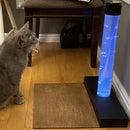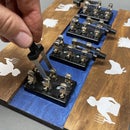Introduction: Balloon Powered Hovercraft
Balloon Powered Hovercraft
This micro-friction Hovercraft glides on a thin film of air over a flat surface. It helps illustrate conservation of momentum -- Newton's Second Law of Motion, '....a body in motion will remain in motion unless acted upon by an outside force...'
The Hovercraft is taped to the top of a CD/DVD/Blu-ray disk (Whatever spare disk you want to 'donate' to the cause) to give it a larger and extremely flat base. The device will almost work by itself but performs much better taped onto a disk.
I have seen similar devices but wanted to make a major improvement - Not having to remove the balloon to inflate it. My design incorporates a one-way valve that uses the neck of the balloon as part of the valve. A tube runs from outside the perimeter of the disk (for easily getting your lips onto it) into the body of the device where it makes a U-turn and comes out just above where it entered.
The sidewall of the balloon closes this air entry opening preventing the balloon from deflating until you blow on the tube and the air pressure in the tube overcomes the air pressure in the balloon and the wall of the balloon lifts to let the air into the balloon. [While you inflate, put your finger over the small bottom hole that lets air escape under the disk.]
This makes for fast inflating and quick turnaround time to keep playing with the Hovercraft instead of fumbling with the balloon.
The design also includes some stabilizing supports to hold the balloon in place and keep the it from flopping around to give the Hovercraft a 'smoother ride'.
Step 1: Materials
Materials:
3D printed Hovercraft (files attached)
CD, DVD, Blu-Ray disk for base (don't use one you want to use/keep!)
Latex Balloon, I am using a '12-inch' size
Tape
Step 2: Design and 3D Printing
I designed the Hovercraft in Fusion 360.
I am very new to this software and this is my first attempt, so please forgive me if it is not as logical and clean as it should be. I tried to use some of the advanced features like the 'pipe' function and I am getting the hang of it. Fusion 360 is a very powerful software package and I'm glad I can use it. Thanks Autodesk!
I have included the .stl and Fusion archive file for the Hovercraft. (The 1st is the Fusion360 file, the 2nd is the .stl file).
The design was sized for the '12-inch' latex balloons that I had on hand. The one-way valve will only work if the neck of the balloon is a little snug on the center column. The balloon supports are also sized based on the balloons I had. The central column and supports may have to be adjusted if they do not fit the balloon you want to use.
The Hovercraft is one single piece that can be printed by itself with no need for supports. I printed it in PLA with a heated bed (50C), just to help insure nothing warped.
Step 3: Line Up - Tape Down - Install Balloon - Inflate and GO!
It's easy to set up the Hovercraft.
Place the Hovercraft on top of the disk. The design has a tongue that lines up with the edge of the disk to help get it centered. Tape the Hovercraft to the disk around its perimeter.
Next install the balloon. Just pull the balloon over the central column, over the air passage and down over the 'bump' to secure it in place.
Use your lung power and inflate the balloon! Hold a finder over the bottom air escape hole to keep the balloon from deflating while you are trying to inflate it. If the filling process makes some screeching sounds (the balloon vibrating over the air inlet opening) you can tilt the balloon toward you while blowing to decrease/stop the sound.
Set the Hovercraft on a flat surface and let it GO! Give it a little push and it should scoot right along until another 'force' interacts with it!
It just keeps going and going and going....
Have fun!
Enjoy!

Participated in the
Design Now: In Motion Contest












